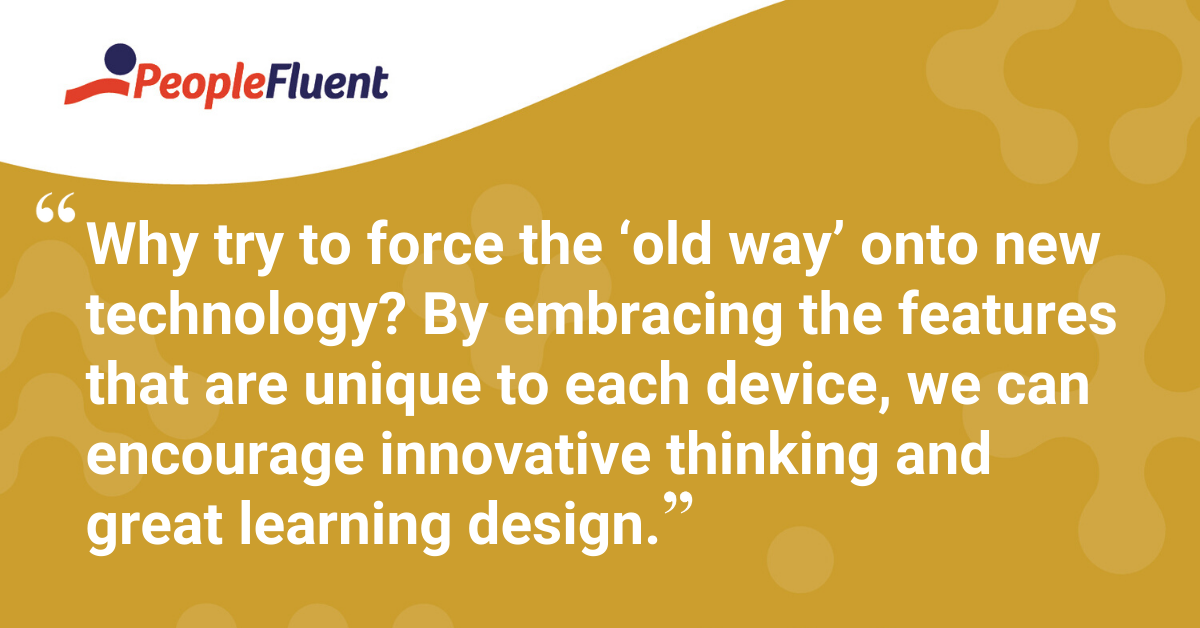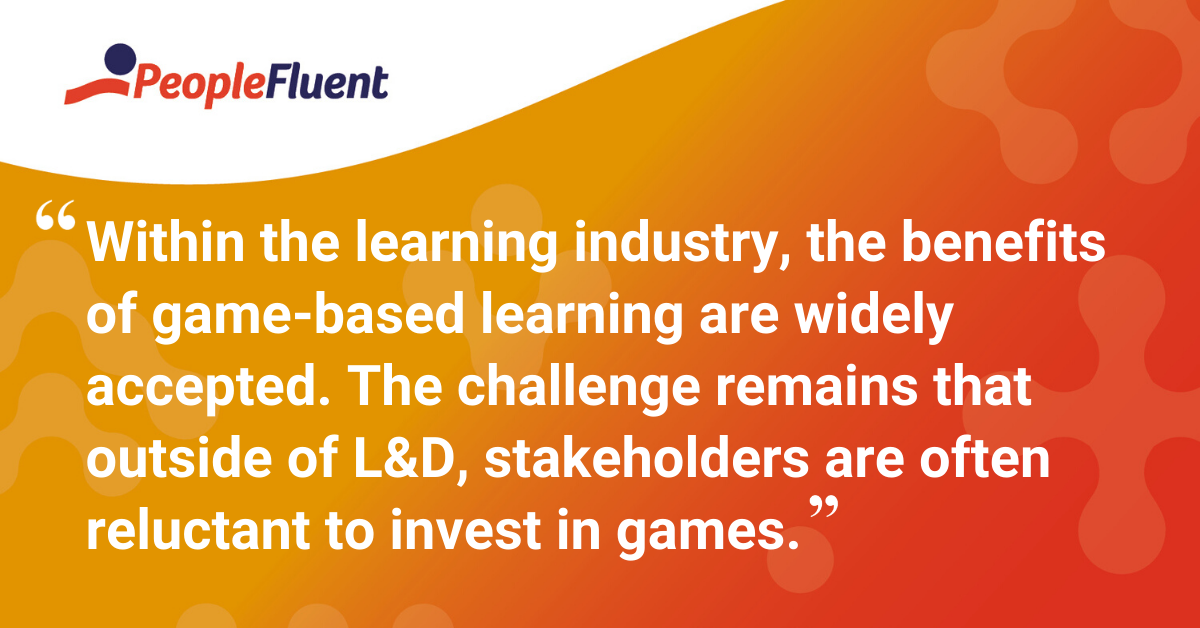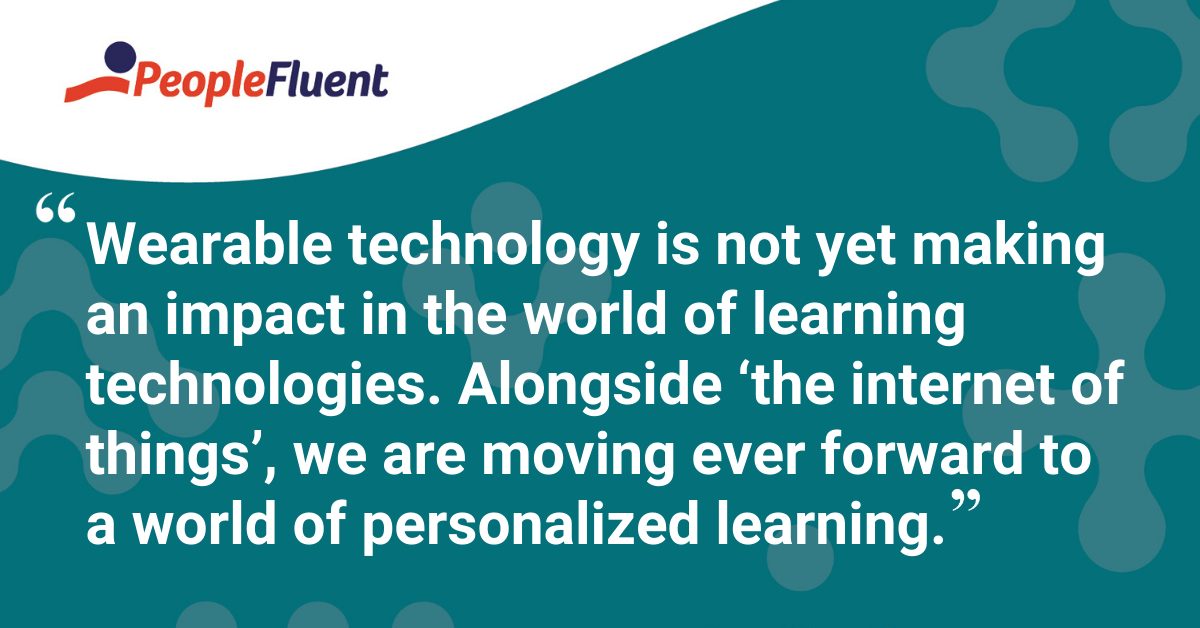Published: Jul 17, 2019Time to read: 8mins Category: Learning
Top 11 Learning Technology Trends from LTSF 2019
PeopleFluent recently attended Learning Technologies Summer Forum 2019 at the ExCeL in London. The one-day event is a follow-up to Learning Technologies, Europe’s biggest L&D expo, and saw PeopleFluent exhibiting alongside sister companies LEO Learning, Gomo and Instilled LXP. As well as demonstrating our PeopleFluent LMS on our stand and during the expo, we also explored the conference to discover the latest learning technology trends from industry experts.
Top Learning Technology Trends of 2019
Learning technology themes from this year's forum included:
- how L&D teams can innovate and disrupt by taking a wider look at how individuals learn in everyday life,
- the benefits of a personalized learning experience,
- and the rising demand for learning systems to offer a touchpoint at the critical moment of transfer in the workplace.
We start with an overview of learning technology trends, from David Kelly, Executive Vice President and Executive Director at eLearning Guild.
Recommended related reading: 'The 13 Must-Have Features of a Learning Management
1) Beyond Learning: A New Way of Looking at Disruption
Disruption can be feared by those set in their ways, but without it, there would be no innovation. Think about how disruptive desktop learning in the ‘90s was, and how it paved the way for eLearning as we know it.
What better way to approach this than by stepping away from the world of education and training to observe personal learning in real-life scenarios? Cue the example of David’s son looking at YouTube instructional videos for a new toy, while the instructions sat in their box, neglected and still in their plastic wrapping.
David said one of his biggest sources for inspiration when ‘thinking outside the box’ is to attend the Consumer Electronics Show (or CES) in Las Vegas because it shows how people naturally interact with technology.
So, the L&D world can gain powerful insights into both personal learning and technology trends from taking a look at the wider world around us.

2) Multi-Device Learning: More Than Responsive Design
It was barely 10:15 in the morning when David challenged us to think of all the ways we’d used our smartphone already. For me, that included Instagram, WhatsApp, Facebook, Google Maps (plus journey planner), Spotify, Safari, my phone camera and checking emails.
This made us consider the functionality of a smartphone (GPS, camera etc) and challenged a responsive design approach that treats mobile simply as a ‘smaller screen’. The point is: why try to force the ‘old way’ onto new technology? By embracing the features that are unique to each device, we can encourage innovative thinking and great learning design.
3) Use Data for Informed Decision Making
‘Big data’ as a concept is not new—it’s more important than ever for L&D teams to prove the business benefit of learning to stakeholders. In 2019, the paradigm has shifted from capturing data (with xAPI standards well established), to making informed decisions with it.
Where judgment and correlations once ruled, data can now be crunched. But this is a skill set that is often limited within L&D teams—or completely absent. This presents a simultaneous challenge and opportunity for learning teams in 2019: data not only shows the value of learning, it also allows learning paths to be personalized and more effective.
4) Powerful, Searchable Interactive Video
We already have the technology to produce interactive learning videos but this is only the beginning. There are exciting developments that could change the future of interactive video.
Video search is currently based on basic meta information such as headers and tags. But what if your search engine could translate and subtitle any audio contained in the video, and then treat this as searchable content? Or what if the user could upload an image (say of a plant), and search (using image recognition) for videos that feature this plant?
Some of these concepts are still in development, but they offer exciting possibilities for learning teams, especially as video functionality continues to integrate into Learning Experience Platforms, such as our sister company Instilled’s LXP, which is showing the power of easily shared video in action.
5) Game-Based Learning and Gamification: What’s the Difference?

The good news is, within the learning industry, the benefits of game-based learning are widely accepted. The challenge remains that outside of L&D, stakeholders are often reluctant to invest in games. We need to get smarter with how we describe the benefits and results of this type of learning.
Gamification is different in that gaming elements (like rewards, leaderboards, and badging) can be applied to a non-game environment or platform. It can be used to motivate a user towards a certain behavior but ethical questions arise: where is the line between motivating and manipulating a user towards an end result?
6 + 7) Learning in the Flow of Work & Microlearning
Workflow learning, microlearning… There’s no shortage of buzzwords around this learning trend, but the emphasis from the LTSF 2019 conference (echoed in other talks) was on offering bite-sized performance support in the moment of need, with minimal disruption and maximum ease.
Want to know more? Our recent blog explored ways to unlock your LMS to support on-the-job learning.
8 + 9) Virtual Reality & Augmented Reality
VR and AR are two immersive technologies that can both engage and excite users—David proposed that the difference being that VR takes you there while AR brings the experience to you.
VR is seeing an increased consumption, with a recent IDC report showing the training sector as the largest commercial market in 2019.
AR, on the other hand, is still developing but continues to be normalized through interactive games outside of the training world (such as Pokėmon Go). The development of headsets or glasses to support AR will open up the doors for this technology to be used more extensively as it will enable the users to have their hands free.
10 + 11) What Next? Artificial Intelligence & the Internet of Things
Wearable technology (think iWatch) is not yet making an impact in the world of learning technologies but has a strong capacity for data gathering. This, alongside the growing data capture possible from everyday, connected items (‘The internet of things’), means we are moving ever forward to a world of personalized learning.
And the final trend David discussed is Artificial Intelligence. It’s a hot topic and one with many negative connotations around machines taking human jobs. The rise of the machines may conjure images of Arnold Schwarzenegger or Will Smith romping through a post-apocalyptic future, but it’s really more about discovering tasks that computers can do more efficiently than humans.

A Quick Summary of Other Conference Highlights
David Perring, Director of Research at Fosway Group
David’s seminar explored learning systems, concluding that to be effective, the future ideal is a learning ecosystem that supports at different touchpoints, including on-the-job support.
The merits of an LMS vs LXP were explored in depth. PeopleFluent actually looked to bridge this gap with our demo at LTSF 2019, where we showcased NetDimensions LMS hosting some functionality from our sister company, Instilled LXP. This development is an exciting nod to the future, recognizing that both systems have benefits for learners.
James Bannerman, Creative Change Agent and Consultant
James combines creativity with psychology to help businesses innovate, and talked us through ways to embrace innovation and avoid adding your company name to the likes of Blockbuster, Kodak and Blackberry, which failed to innovate fast enough.
To avoid the enemies of innovation (which he says are complacency, conceit, and conservatism), try these five ways to think creatively:
- New connections. In L&D, that could mean connecting different people or teams together for fresh perspectives.
- New alterations. Alter things in new ways, for example changing the speed of delivery, structure, or shape. Consider the difference between an espresso or latte, both born from the same base ingredient: coffee!
- New navigations. If you want new ideas, go on a journey to somewhere different.
- New directions. Take a look at your process with fresh eyes and turn things around. Could you change the sequence of what you do, turning it back to front, or upside down?
- New oppositions. Challenge the status quo, even if it’s scary. Uber and AirB&B ‘broke the rules’ and are now the norm.
Stella Collins, Creative Director at Stellar Learning
Stella’s conference talk explored learning and the mind, and considered the importance of how we approach these learning types:
- Skills
- Knowledge
- Habits
Each of these learning types is different and activates different parts of the brain. Meta-learning takes a granular approach to breaking down and analyzing how learning happens. By analyzing and unpicking learning types using this methodology, L&D can tailor learning programs accordingly.
Discover How Learning Builds Skills and Ensures Compliance
Design, deploy, track, analyze, and report on enterprise learning and compliance programs. PeopleFluent helps you execute your programs seamlessly, so employees upgrade their skills and you get results.